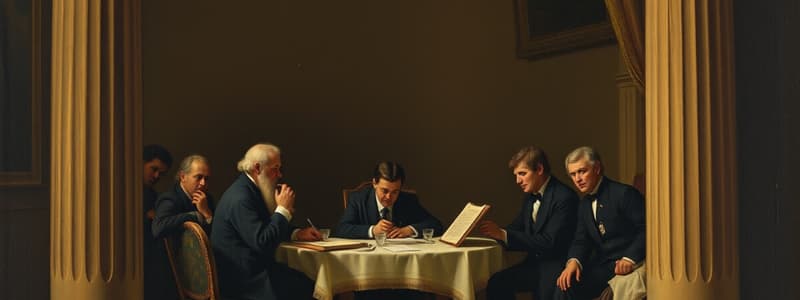Podcast
Questions and Answers
What presents the fundamental principles of a government and establishes the basic structures and procedures by which the government operates to fulfill those principles?
What presents the fundamental principles of a government and establishes the basic structures and procedures by which the government operates to fulfill those principles?
Constitution
The men who crafted the US Constitution were most representative of?
The men who crafted the US Constitution were most representative of?
Lawyers and Businessmen
Which of the following is not central to the government created by the US Constitution?
Which of the following is not central to the government created by the US Constitution?
- Bicameral Legislature
- Unicameral Legislature (correct)
- Separation of Powers
- Checks and Balances
Who can ratify amendments to the Constitution?
Who can ratify amendments to the Constitution?
When was the Bill of Rights added to the Constitution?
When was the Bill of Rights added to the Constitution?
Why did the smaller states oppose the Virginia Plan?
Why did the smaller states oppose the Virginia Plan?
Which of the following stipulations within the US Constitution originally created an indirect democracy?
Which of the following stipulations within the US Constitution originally created an indirect democracy?
The case that established the Supreme Court's power to interpret the US Constitution was?
The case that established the Supreme Court's power to interpret the US Constitution was?
Which amendment to the Constitution gave the voters the power to elect their senators?
Which amendment to the Constitution gave the voters the power to elect their senators?
Match the following terms with their definitions:
Match the following terms with their definitions:
The first Constitution of the United States was called?
The first Constitution of the United States was called?
Who or what has the power to determine whether an action taken by any government official or governing body violated the Constitution?
Who or what has the power to determine whether an action taken by any government official or governing body violated the Constitution?
Which of the following made the new government formed by the US Constitution stronger than the government formed by the Articles of Confederation?
Which of the following made the new government formed by the US Constitution stronger than the government formed by the Articles of Confederation?
The Constitution can be revised through both formal amendment and judicial interpretation.
The Constitution can be revised through both formal amendment and judicial interpretation.
Match the following terms with their definitions:
Match the following terms with their definitions:
As a general matter, how does support for ratification change as one moves from west to east on the map?
As a general matter, how does support for ratification change as one moves from west to east on the map?
Of those states that would eventually secede from the Union, what distinguishes Georgia on this map?
Of those states that would eventually secede from the Union, what distinguishes Georgia on this map?
Amendments to the US Constitution are difficult to ratify.
Amendments to the US Constitution are difficult to ratify.
What is required for the members of Congress to propose an amendment to the Constitution?
What is required for the members of Congress to propose an amendment to the Constitution?
If the Supreme Court does not review constitutional interpretations made by a lower federal court, then the?
If the Supreme Court does not review constitutional interpretations made by a lower federal court, then the?
Flashcards are hidden until you start studying
Study Notes
Constitution Overview
- The Constitution presents the fundamental principles of governance and establishes the structures and procedures for government operation.
- The first constitution of the United States was the Articles of Confederation.
Key Players and Opposition
- The framers of the US Constitution were primarily lawyers and businessmen.
- Smaller states opposed the Virginia Plan due to representation in the legislature being based on state population, fearing loss of influence.
- Anti-Federalists opposed ratification of the Constitution, concerned about central government power affecting state authority and individual freedoms.
- Federalists supported the Constitution as presented by the Constitutional Convention in 1787.
Legislative Structure and Representation
- The US Constitution established a bicameral legislature, unlike the unicameral legislature which is not central to it.
- The Great Compromise created a two-chamber Congress, with the House of Representatives based on population and the Senate providing equal representation for states.
Amendments and Ratification
- Amendments to the Constitution can be proposed by a two-thirds vote in both the House of Representatives and the Senate.
- State legislatures are responsible for ratifying amendments to the Constitution.
- The Bill of Rights was added to the Constitution after some states refused to ratify it without a guarantee of individual liberties.
- The process of ratifying amendments to the Constitution is difficult.
Compromises and Key Cases
- The Three-Fifths Compromise counted each slave as three-fifths of a person for taxation and congressional apportionment.
- The case of Marbury v. Madison established the Supreme Court's power to interpret the Constitution.
Electoral Process and Democracy
- The Electoral College, alongside the Three-Fifths Compromise and the Connecticut Compromise, originally established an indirect democracy.
- The Seventeenth Amendment allowed voters to directly elect their senators, rather than state legislatures doing so.
Judicial Authority
- The Supreme Court determines whether actions taken by any government official violate the Constitution, upholding interpretations made by lower federal courts when not reviewed.
Geographic Support and Opposition
- Support for ratification generally increased from west to east in the United States.
- Georgia was unique among states that would later secede, having no areas where a majority was against ratification.
Studying That Suits You
Use AI to generate personalized quizzes and flashcards to suit your learning preferences.




